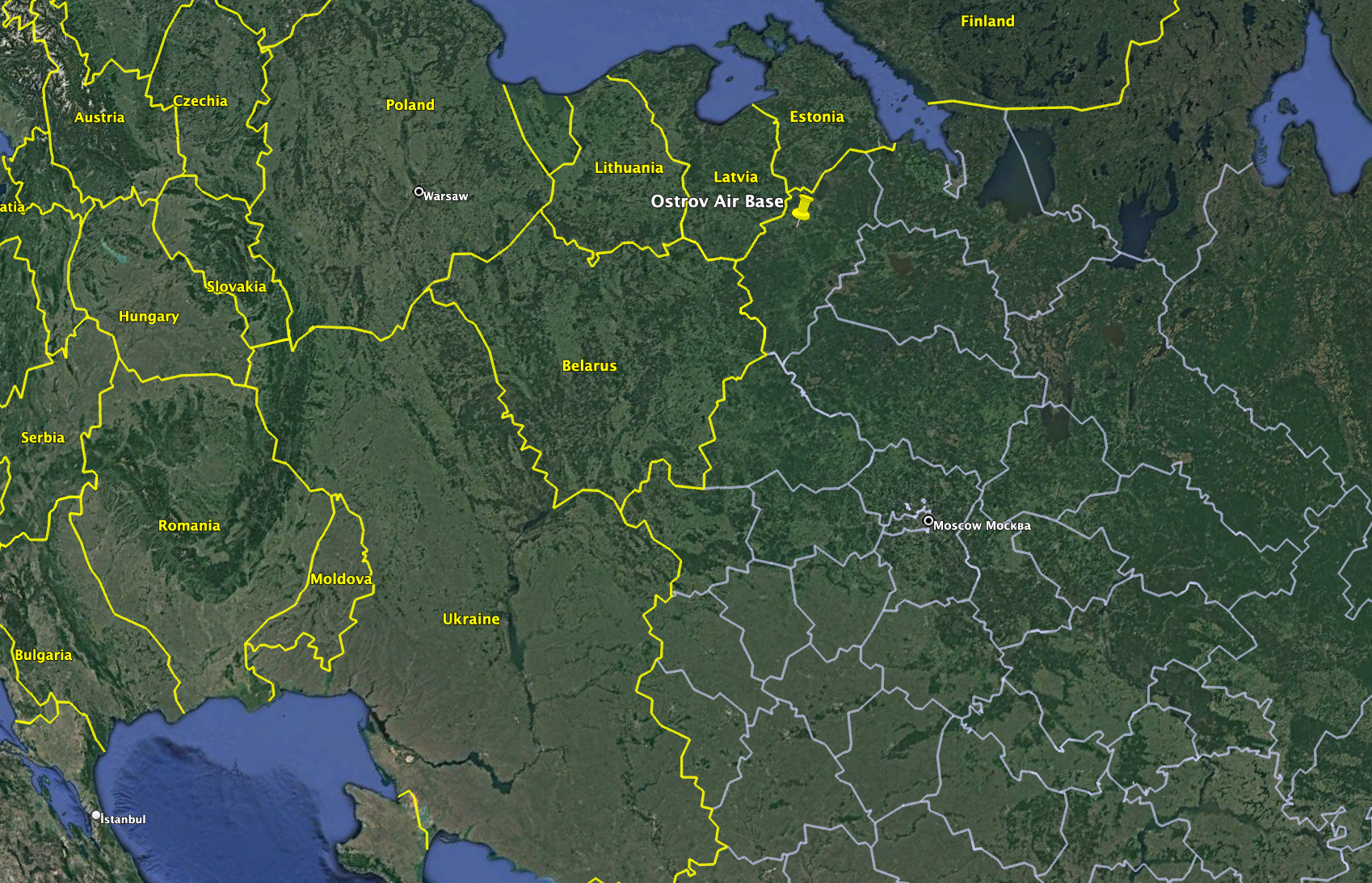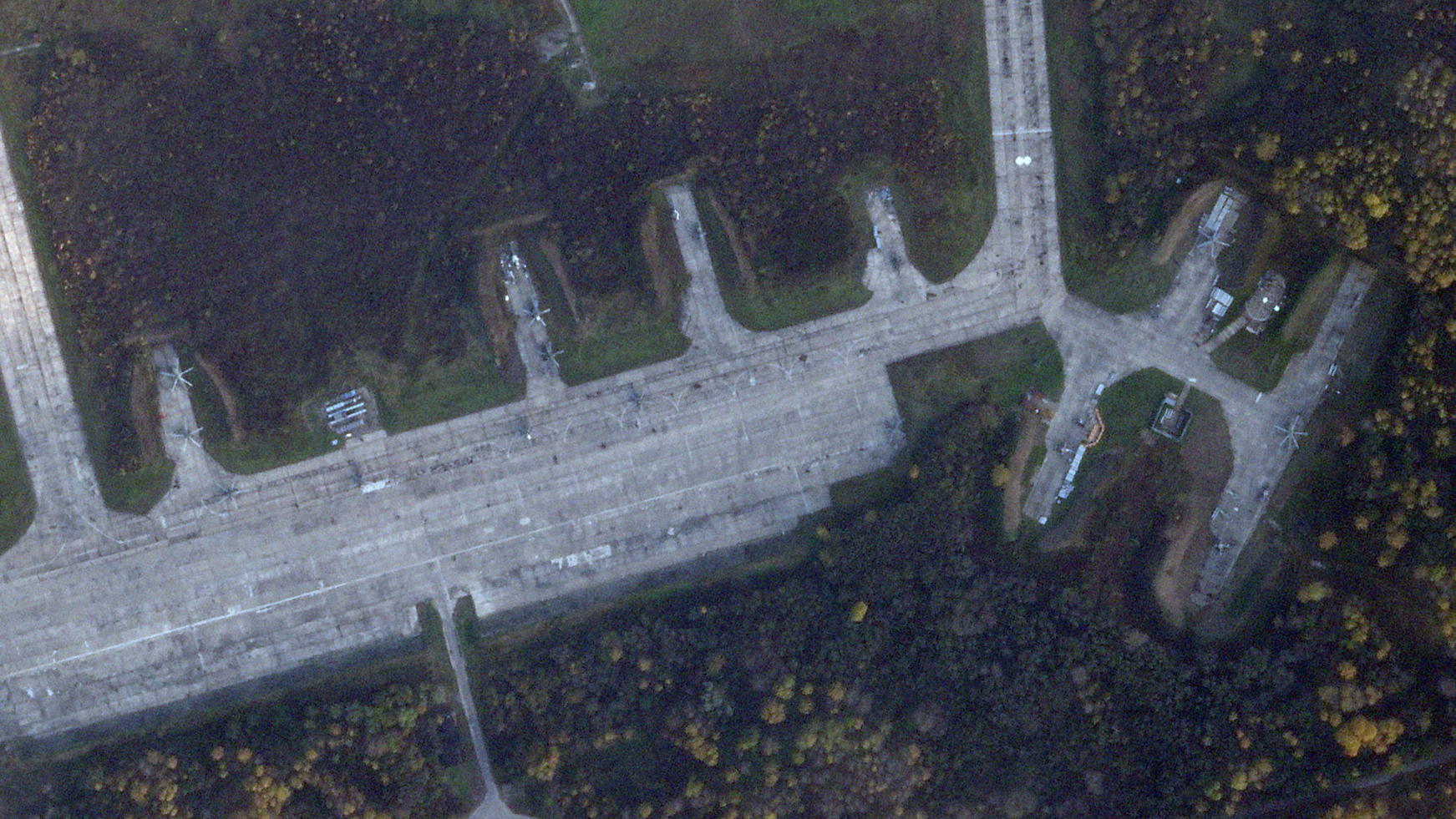An apparent sabotage attack against a Russian airbase in the Pskov region, in the far west of the country, was apparently filmed by the operatives before they detonated explosives placed on the attack helicopters. Video purportedly showing one of the saboteurs assembling explosive devices next to a Russian Ka-52 Hokum-B attack helicopter has now appeared online. Although it’s not yet possible to verify its authenticity at this time, the fact that three intact Ka-52s also appear in it is noteworthy — Ukraine is not known to have captured this many examples intact.
The pro-Russian Fighterbomber Telegram channel, which regularly brings news of Russian military aircraft activities over Ukraine and elsewhere, also seems to consider the video to be genuine, with a comment noting that “The appearance of this video was only a matter of time and personally, I was not surprised at all.” The same analysis goes on to criticize the poor level of defensive preparedness at the base and around Russian military infrastructure more generally. It does also claim that the helicopters involved were not in service (“scrap metal”) and that no persons were injured.
Explosions at the airfield destroyed two Russian Ka-52 and one Mi-28N attack helicopters, according to the Ukrainian defense intelligence service. Ukrainian authorities have not yet claimed responsibility for any attack, but it does seem to bear the hallmarks of a raid by saboteurs, which is all the more impressive considering the base is roughly 400 miles from the Ukrainian border and much closer to Latvia.


“A powerful explosion went off at the Veretye military airbase (Pskov region, Ostrov-5) on the night before October 31 [i.e. October 30],” the Ukrainian defense intelligence service, or GUR, said in a statement. No details were given about the possible cause although the same report adds that another two Ka-52s were “significantly damaged.” The explosion is said to have scattered the wreckage over a radius of 220 yards. It’s not known if there were any casualties as a result.
Other Russian Telegram channels also reported the incident, the VChK-OGPU account citing an anonymous source stating that three explosions were heard in total at around 10 PM. VChK-OGPU only mentions two helicopters as “damaged” and that the cause is unclear.
An account on the Baza channel offers further details, suggesting that the helicopters in question were at the airfield for repairs. If that’s the case, they may well have been examples rotated out of the Ukrainian theater for regular maintenance or perhaps even battle damage repair.



According to Baza, the Russian Ministry of Defense has yet to comment on the incident. However, the Western Military District that’s responsible for the base told journalists it would provide details once they were available.

While not claiming that Ukrainian or pro-Ukrainian saboteurs were responsible for the attack, the GUR does note that Russian personnel at the base have been put on alert including to “search for sabotage groups” that might be preparing similar raids.
At this stage, however, an accident of some kind cannot be ruled out. After all, Russian airbases have had their fair share of non-combat incidents and accidents since the start of the campaign in Ukraine. At least some of these may well also be related to the additional stresses and strains imposed by the conflict.
The airbase in question, normally known simply as Ostrov in English, is the home of the 15th Army Aviation Brigade, a relatively recent organization that was established in 2013. Prior to that point, it had been used for training naval aviation aircrew.

The brigade is thought to operate a squadron of around 12 Mi-28N and a smaller number of Mi-35M attack helicopters, one squadron of 12 Ka-52s, one squadron of 16 Mi-8MTV-5 combat transport helicopters, plus detachments of Mi-26 heavy transport helicopters and Mi-8MTPR-1 Rychag electronic warfare helicopters, a type that you can read more about here.
If the Ukrainian account is correct, and two Ka-52s have been destroyed and another two damaged, that represents a significant portion of the helicopters of this type normally found at the base. It’s also possible, however, that the current total could have fluctuated on account of deployments to the Ukrainian theatre or incoming aircraft undergoing maintenance. Certainly, Ka-52s from the base have been engaged in combat over Ukraine.
Either way, the Ka-52 fleet, in particular, has been subject to a steady toll of attrition since the war began, with a string of losses in recent weeks.
Last week, the U.K. Ministry of Defense released its assessment of Ka-52 losses since the all-out invasion of Ukraine began in February. The MoD believes that Russia has lost more than a quarter of its total in-service fleet of Ka-52s, based on an “in-service fleet” of 90 at the start of the campaign. This is a smaller number than the total inventory, which was around 120 at the time, likely a reflection of either the total helicopters deployed for operations in Ukraine or those available for combat operations across the country. You can read our initial report on this here.
The MoD’s intelligence assessment is based on at least 23 of the Ka-52s having been shot down or lost since the February 24 invasion.
“Russian attack helicopters have likely suffered particular attrition from Ukrainian man-portable air defense systems (MANPADS), while the helicopters frequently operate with less consistent top-cover from combat jets than they would expect under Russian military doctrine,” the U.K. MoD said.
The MoD pointed to Russia’s inability to maintain adequate air superiority, and depleted stocks of artillery ammunition, as reasons for its commanders to increasingly resort to high-risk attack helicopter missions. The degree of risk to which these helicopters face is also demonstrated in multiple videos showing them launching unguided rockets on a ballistic trajectory, keeping the aircraft out of the highest-threat areas but resulting in questionable efficiency. You can read more about the tactic here.

But as well as being shot out of the sky, it seems Ka-52s and other Russian helicopters are now under threat on their home bases, even those far from Ukraine’s borders.
That Russian airbases were a target for Ukrainian offensive operations seemed to be made clear on the second day of the war, when there were unconfirmed reports of an apparent attack on the Russian airbase at Millerovo, alleged to be the result of a Tochka missile strike. The details of what happened at the airbase — less than 20 miles from the Ukrainian border — remain unclear and it remains possible that the incident was an accidental fire rather than a Ukrainian strike.
The fire at Millerovo Air Base on February 25:
Reports that the bomber base at Shaykovka, about 140 miles north of the Ukrainian border, was hit by a Ukrainian suicide drone in early October proved inconclusive.
Otherwise, Russian airbases in occupied Crimea have also been subject to apparent Ukrainian attacks. The most dramatic of these was the August blasts at Saki Air Base that left at least 10 jets seen seriously damaged or destroyed.

Evidence of explosions at Gvardeyskoe, another Crimean airbase, also in August, proved to be far less conclusive. On this occasion, smoke was seen rising from the facility, but satellite imagery didn’t appear to show any apparent damage to aircraft there.
In the aftermath of the Crimean incidents, there were reports citing Ukrainian officials claiming that a team, possibly made up of Ukrainian special operations forces, local partisans, or a mixture of both, had attacked the installations.
While Crimea is a far closer target than Ostrov, attacking either in this way would present huge difficulties, not least actually penetrating the airbase perimeters to deliver explosives manually, which is what the video suggests.
Interestingly, however, the airbase at Ostrov has shown itself to be entirely pregnable to intruders — albeit unarmed ones, during peacetime — in the past.
In December 2019, a group of self-styled ‘extreme photographers’ entered the airbase “completely unhindered,” according to one report, and then “took detailed photos and videos of both the installation itself and the latest Ka-52 attack helicopters in service with the Russian Aerospace Forces’ 15th Army Aviation Brigade.”
Once there, they took multiple photos of apparently serviceable Ka-52s, including within their cockpits, as well as long-stored Russian Navy Su-24 strike aircraft and Be-12 amphibians. The same report added that “the photographers limited themselves to the needs of their hobby, not paying attention to the fact that they could easily remove any component from helicopters.”
It’s worth noting that security lapses at Russian military installations, airbases, in particular, are hardly a new thing. While it might be expected that security would be tightened during the conflict in Ukraine, many of the troops and security personnel previously responsible for securing the northern Russian border with Europe and NATO and nearby installations have been pulled into the Ukraine operation. Locations like Ostrov could well be minimally manned at this point. On the other hand, it’s also possible that, at around 400 miles from that country, Ostrov was judged to be relatively safe.
We do know that Ukrainian military and intelligence services conduct extensive activities, including sabotage efforts, in areas of the country that Russia occupies, as well as inside Russia proper. Units tasked with these missions are understood to work or at least coordinate with local partisans. You can read more about all this in The War Zone’s past exclusive interview with members of one of these specialized Ukrainian contingents, known as the Shaman Battalion, here.
Whatever it was that caused the reported explosions at Ostrov, the result appears to have further dented Russia’s attack helicopter fleet and, once again, highlighted the fact that its aircraft and other assets are not safe, even if relatively far from the Ukrainian battlefields.
Contact the author: thomas@thedrive.com
